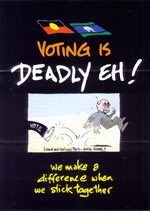Aboriginal timeline: Politics
Found 175 results for your search. Showing page 2 of 9.
1938
-
150 years after European occupation the Aboriginal Progressive Association declares a Day of Mourning. It holds a conference in Sydney, a landmark meeting of Aboriginal peoples, to bring attention to the plight and imposed conditions of Aboriginal people, and campaign for full citizenship and land rights. This is the first of many Aboriginal protests against inequality, injustice, dispossession of land and protectionist policies, and is considered the start of the Aboriginal political movement.
1939
-
As a result of the 1937 conference Queensland passes legislation allowing Aboriginal people to receive workers’ compensation, and the Northern Territory government sets up a Native Affairs Branch.
1940
-
Amendments to the NSW Aborigines protection legislation results in the replacement of the Aborigines Protection Board with the NSW Aborigines Welfare Board. Responsibility for Aboriginal education is transferred to the Department for Education, which takes control of reserve buildings and starts to provide trained teachers. ‘Aboriginal’ schools provide education beyond Grade 3.
-
In the 1940s most federal social security benefits are extended to Aboriginal people.
-
White Australia policy succeeds: 99% of Australia’s 7 million people are white.
1941
-
The Child Endowment Act is passed but declares no endowment should be paid to dependent Aboriginal people.
1943
-
A further amendment to the Aboriginal protection legislation in NSW gives two Aboriginal people – one ‘full-blood’ and one ‘half-caste’ – representation on the Aboriginal Welfare Board. Walter Page and William Ferguson, both Aboriginal Progressive Association members, take up the positions.
-
The NSW government passes the Aborigines Protection (Amendment) Act 1943 which in Section 18c introduces Exemption Certificates that allow certain Aboriginal people to be exempted from the restrictive legislation and entitled to similar rights as non-Aboriginal people, e.g. to vote, drink alcohol and move freely and send their children to school. In return they "shall be deemed not to be an aborigine [sic]" which means they have to give up their cultural activities and contacts to family and community. The Act remains in force until 1969.
Aboriginal people use the derogatory terms ‘dog tags’ or ‘dog licences’ to refer to the certificates. Giving up their traditional lifestyle is promoted to Aboriginal people as the only opportunity to overcome poverty, gain work and access to education and social welfare benefits.
1948
-
The Universal Declaration of Human Rights is adopted by the newly-formed United Nations and supported by Australia.
-
The Commonwealth Citizenship and Nationality Act 1948 for the first time makes all Australians, including all Aboriginal people, Australian citizens. But at state level they still suffer legal discrimination.
1949
-
Aboriginal people are given the right to enrol and vote at federal elections provided they are entitled to enrol for state elections or have served in the armed forces.
-
The Convention on the Prevention and Punishment of the Crime of Genocide is ratified by Australia. It comes into force in 1951.
1951
-
The federal government convenes the Australian Conference for Native Welfare, with all states and territories represented except Victoria and Tasmania, which claim to have no Aboriginal ‘problem’. The conference officially adopts a policy of ‘assimilation’ for Aboriginal people.
"Assimilation means, in practical terms, that it is expected that all persons of Aboriginal birth or mixed blood in Australia will live like white Australians do." [1]
1953
-
The Northern Territory Welfare Ordinance makes Aboriginal people wards of the government, basically making Aboriginal adults and children, minors.
1954
-
Queen Elizabeth visits Australia for the first time and in Canberra signs the Aborigines Welfare Ordinance 1954 that permits the ethnic cleansing of the Australian Capital Territory, clearing it of resident Aboriginal people.
1957
-
Victorian Aborigines Welfare Board replaces the Board for the Protection of Aborigines. The Welfare Board is abolished in 1967.
-
In the Northern Territory the powers of the Chief Protector over Aboriginal children are repealed.
1960
-
Aboriginal people become eligible for social service benefits.
1961
-
Non-Aboriginal women Muriel Langford, Joyce Wilding and Daisy Marchisotti set up the One People of Australia League (OPAL), a moderate Aboriginal rights organisation, in Brisbane. Branches are set up all over Queensland. The party brings together Aboriginal and non-Aboriginal people and aims to support Aboriginal people in Brisbane and QLD so that they and non-Aboriginal people could become "one people". This aim, and because it received funding from the Queensland government, led to criticism that OPAL supported assimilationist policies. Its main focus was on welfare and housing, and it owned two hostels.
In 1960 Aboriginal man Neville Bonner became associated with OPAL. He served as one of the league’s directors for several years and was the Queensland president in 1968-74.
1962
-

Aboriginal right to vote. A lot of Aboriginal people exercised their right to vote in the 2007 federal elections which kicked the Howard government out of parliament. The Commonwealth Electoral Act is amended to give Aboriginal people in Queensland, Western Australia and the Northern Territory the right to vote in federal elections. Aboriginal people are not made to register, but once they have, voting is compulsory for them, as it is for every Australian. Compulsory enrolment is not required until 1984.
References
View article sources (0)
[9711] 'Timeline of legislation affecting Aboriginal people', DECS Curriculum Services, www.aboriginaleducation.sa.edu.au
